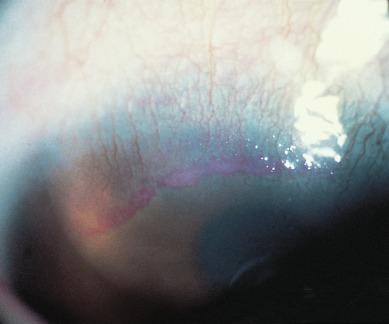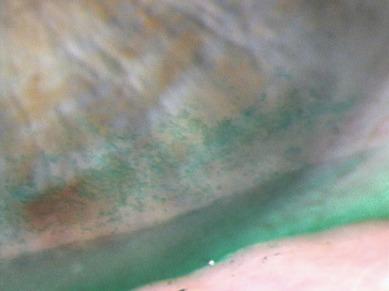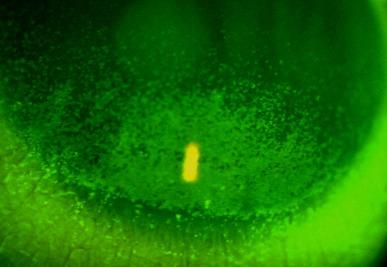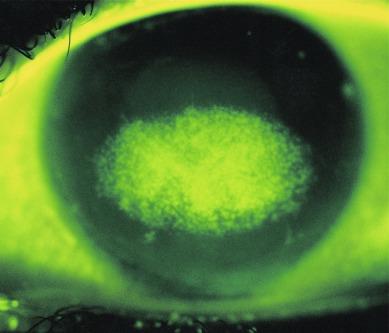Physical Address
304 North Cardinal St.
Dorchester Center, MA 02124
The use of fluorescein in the examination of corneal integrity was introduced by Pflüger in 1882, just 6 years before the first fitting of contact lenses to humans was reported by Fick. However, it is only in the past 50 years that fluorescein has been used routinely by clinicians for this purpose.
Corneal staining is probably the most familiar of all potential contact lens complications since its clinical importance is well established and it is easily observed. Strictly speaking, corneal staining is not a condition in itself – rather, it is a general term that refers to the appearance of tissue disruption and other pathophysiological changes in the anterior eye as seen with the aid of one or more of a number of dyes, such as fluorescein, rose bengal and lissamine green. These dyes are sometimes referred to as ‘vital stains’, suggesting that they stain living things; however, this is a misleading term because such stains can be taken up by inorganic material.
It has become a convention among clinicians to use the term ‘corneal staining’ to describe the appearance of bright areas of fluorescence in the epithelium after instillation of the dye fluorescein and illumination with cobalt blue light ( Fig. 18.1 ). Throughout this chapter, it is to be assumed that corneal staining refers to staining with fluorescein , unless otherwise stated.
Before considering corneal staining in contact lens wearers, the extent of staining in the normal population should be noted. Schwallie et al. evaluated corneal fluorescein staining in 16 normal, non-lens-wearing subjects over a 2-week period. The average duration for an episode of staining above the group median (grade 0.5) was found to be 1.2 ± 0.4 days. For both eyes, the most prevalent location of staining was the inferior region (50%), followed by the nasal region (20%). Overall, a mean staining grade of 0.5 to 0.6 was found. In a similar study, Dundas et al. found some degree of corneal staining on 79% of the corneas of 102 normal subjects they examined.
The prevalence of corneal staining of any degree of severity in a population of contact lens wearers is thought to be as high as 60%, but often staining is of a low level and generally clinically insignificant. Indeed, as noted earlier, corneal staining is frequently observed in non–lens wearers. Brautaset et al. reported an incidence of 19.5% corneal staining among 338 adapted hydrogel lens wearers, with no subjects displaying staining greater than grade 2.
Begley et al. found that the average overall staining grade for both eyes of 98 asymptomatic soft contact lens wearers was 0.5. Corneal staining between the two eyes was positively and significantly correlated. One-third of the subjects who participated in the study had notable corneal staining. Jalbert et al. measured levels of corneal staining over a 2-year period in those successfully using daily-wear and extended-wear disposable hydrogel contact lenses. Their results were similar to those of Begley et al. ; overall levels of corneal staining were low, with median values below or equal to grade 0.5 in all groups. There was no difference in the extent, depth or geographical distribution of corneal staining between the daily-wear and extended-wear groups. Staining was more frequently recorded in the superior and inferior areas of the cornea than in the central, nasal or temporal regions.
In perhaps the largest survey ever undertaken of the ocular response to contact lens wear (66,218 patients), Hamano et al. determined the prevalence of clinically significant staining (corneal erosion or superficial punctate keratitis greater than grade 2; see further in the chapter) to be 0.9% in soft lens wearers, 0.5% in rigid lens wearers and 1.3% in polymethyl methacrylate lens wearers.
Among symptomatic contact lens wearers presenting to hospital clinics around the world between 2009 and 2018, the reported incidence of corneal staining ranged from 2% to 87% ( Table 18.1 ).
| Author | Country | Year | Population size studied | Retrospective or prospective | Prevalence |
|---|---|---|---|---|---|
| Li et al. | China | 2018 | 141 | Retrospective | 2.1% |
| Sapkota et al. | Nepal | 2013 | 4064 | Retrospective | 2% |
| Lee et al. | USA | 2012 | 1369 | Prospective | 87% |
| Teo et al. | Singapore | 2011 | 953 | Prospective | 24% |
| Nagachandrika et al. | India | 2011 | 1255 | Retrospective | 4.8% |
| Radford et al. | UK | 2009 | 877 | Prospective | 21.3% |
A variety of vital stains can be used to highlight various aspects of surface tissue pathology, and a review of the types of stains and their application for staining the conjunctival surface is discussed in detail in Chapter 11 . Following is a brief overview of the use of the three main stains used in contact lens practice to investigate various abnormalities and pathology of the corneal surface.
Fluorescein is combined with sodium salt to make it more soluble in water. Although it is available as a 2% solution, fluorescein is rarely used in this form because it supports the growth of bacteria which are potentially pathogenic to the eye, such as Pseudomonas aeruginosa . Therefore, paper strips impregnated with fluorescein are preferred; these strips have an orange-yellow colour. Fluorescein can be instilled by wetting the strip with two drops of sterile unpreserved saline, having the patient look up and briefly and gently touching the strip, or preferably by letting a large drop fall from the paper, on the inferior bulbar conjunctiva.
When examining a fluorescein-stained eye, it is important to prompt the patient to blink frequently. If the patient blinks infrequently, the tear film will break up, leaving large dark areas of non-fluorescence which could (a) mask true staining or (b) be misinterpreted as non-staining background fluorescence. Fluorescein break-up in the absence of blinking is the basis of an important test of tear film stability (see Chapter 9 ).
Because fluorescein has a molecular weight of 376, it is smaller than the pore size of many hydrogels and can be absorbed into the lens, resulting in a yellow stain. Therefore, as a precaution, the eye should be irrigated with sterile saline before inserting a soft lens after examination of the eye with fluorescein. If a reusable lens does become stained with fluorescein, it usually washes out after the next disinfection cycle.
Fluorescein is generally considered inert and safe; however, Kaimbo reported a rare case of syncope and anaphylactic shock in a patient who received topical fluorescein to a corneal abrasion caused by a fingernail.
High-molecular-weight fluorescein, known as fluorexon , (molecular weight 710) is available but not used widely because it has relatively low fluorescent properties and causes discomfort and stinging in some patients.
Sequential staining refers to the repeated application of fluorescein over a period of minutes followed by observation with the slit lamp biomicroscope in the usual way. This has been suggested as a more sensitive technique which is predictive of epithelial complications of contact lens wear, although this link has not been proven. It is likely that sequential staining merely results in high concentrations of fluorescein in the eye that causes a toxic epithelial response. The value of this technique is therefore questionable.
Rose bengal is a mildly toxic bright red stain which is adsorbed to and absorbed by compromised epithelial cells, mucus and fibrous tissue ( Fig. 18.2 ). It is available as a 1% solution or as impregnated filter strips. Davis and Lebow suggested that much better results are obtained if the solution form is used. After instillation, the eye is observed in white light.

In the absence of a complete tear film – and especially in the case of mucus deficiency – rose bengal is taken up by healthy epithelial cells. Accordingly, this stain is especially useful for investigating dry eye conditions; that is, a dry eye may display extensive staining with rose bengal, especially if there is a mucus deficiency.
An alternative stain with similar properties to rose bengal is lissamine green; both agents stain degenerated and dead epithelial cells and mucus. The stained regions appear as a vivid green colour ( Fig. 18.3 ). Lissamine green is better tolerated by patients compared with rose bengal and is as effective as rose bengal in evaluating the surface of the eye. However, Emran and Sommer believed that lissamine green is an inadequately sensitive test for practical use.

Fluorescein staining should be considered a routine procedure to be performed as part of the contact lens aftercare examination. Although corneal staining has received extensive interest amongst the academic community, most practitioners in Europe do not routinely use fluorescein at aftercare visits.
Corneal staining after instillation of fluorescein is observed as a bright green fluorescence and may present in an infinite combination of shapes, locations, depths and intensities. The position is generally noted as superior, inferior, temporal, nasal or central. The depth of staining is noted as deep or superficial. A large number of terms has been used to describe the various forms of appearance of staining. Some of these have assumed the status of ‘syndromes’ based on frequently observed characteristic patterns of tissue damage. These various appearances are considered briefly in the next sub-sections.
The lack of a standard nomenclature for labelling various appearances of corneal staining has resulted in practitioners adopting different terms to describe the same condition. Accurate record keeping, including grading, making careful sketches or attaching slit lamp photographs to record files, is therefore paramount.
Perhaps the most often noted form of disturbance is punctate staining, whereby small superficial discrete dots are observed on the corneal surface ( Fig. 18.1 ). This is also referred to as micropunctate staining , superficial punctate erosion (SPE) or superficial punctate keratitis (SPK). Intense punctate staining is sometimes called ‘stipple staining’.
A vast array of closely separated punctate spots gives rise to a ‘diffuse’ appearance. The terms SPE and SPK are also used to describe this appearance ( Fig. 18.4 ).

The overall pattern of fluorescence may be so diffuse as to obscure the constituent elements of staining, resulting in an appearance described as confluent or coalescent staining ( Fig. 18.5 ).

Become a Clinical Tree membership for Full access and enjoy Unlimited articles
If you are a member. Log in here